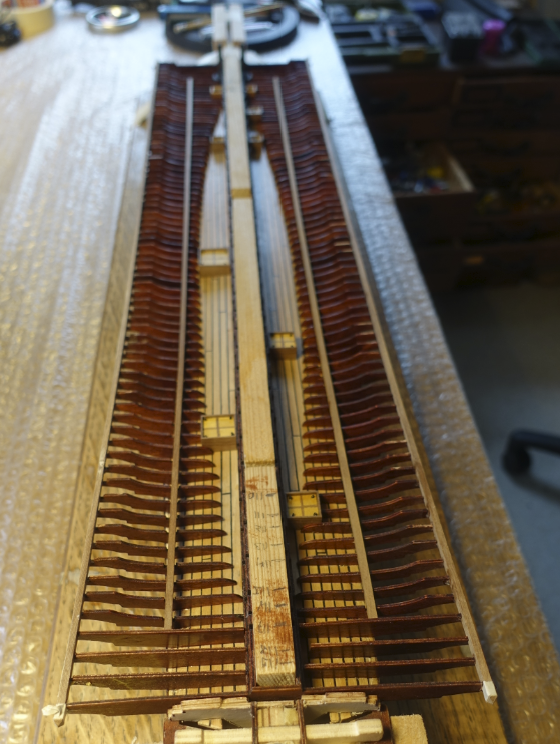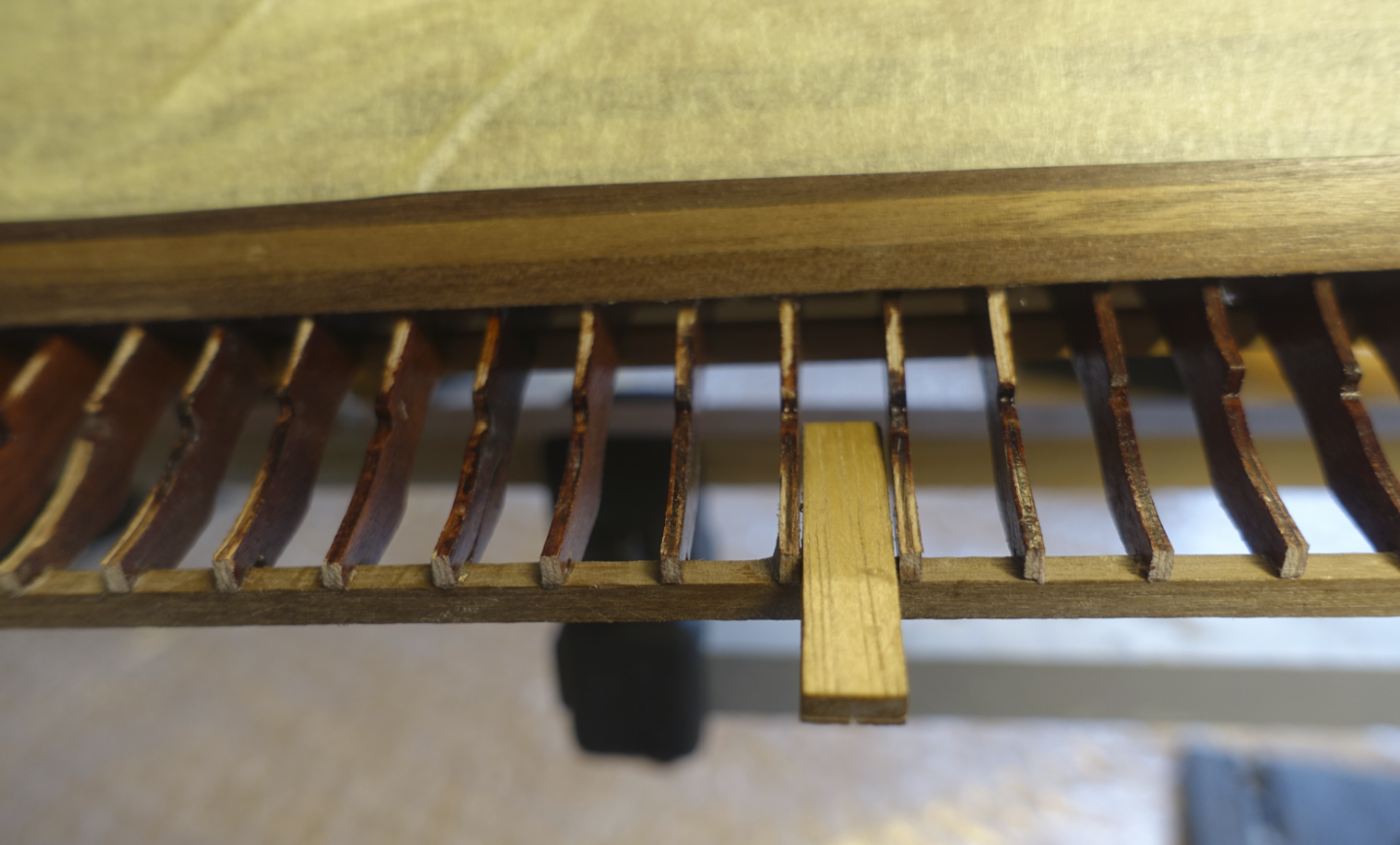
Clark
Members-
Posts
305 -
Joined
-
Last visited
Content Type
Profiles
Forums
Gallery
Events
Everything posted by Clark
-
For adapting the arches covering the kings platform, I used and sanded the template provided by Corel before proceeding the way Corel manual suggests. This because the arches had to be put in line with the arches already glued at the stern platform. It took some time but it was the best way to fit the strips. Railings were fixed before putting the arch construction on. According to Corel there should be a window line between the railings: So far none of the Reale builders (fmodajr, bender, gimo) liked it. Me neither. I replaced it by some pillars.
- 112 replies
-
- corel
- reale de france
-
(and 1 more)
Tagged with:
-
Hi Frank, I am almost at the same point you are now. When building the Xebec, I had the same problem but used the flexible wood and it worked, althought it took a lot of efforts to bend the ends. Nevertheless, stressing of wood was no problem. Thus I will probably rely on the the flexible ones. For that purpose, I checked the templates of Reale Corel provides (#233 and others). They are not completely in line when placed in order and have to be sanded. Did you have the same problem? I am a bit disappointed of the Corel material. Your solution seems much better than the flexible wood. Clark
- 510 replies
-
- reale de france
- corel
-
(and 1 more)
Tagged with:
-
Frank, I was also wondering how to manage the problem of windows since they are visible from the outside only. Moreover, the false windows provided by Corel do not look very realistic. I do not like them. I will probable leave the space between the rails completely free. At present we all are watching the battle in your Country which will surely have a strong impact on Europe. Clark
- 510 replies
-
- reale de france
- corel
-
(and 1 more)
Tagged with:
-
The floor will be covered by arches but I know that is there. Thanks for stopping by. Clark
- 112 replies
-
- corel
- reale de france
-
(and 1 more)
Tagged with:
-
The king’s platform at the stern is ready. Compass symbol is surrounded by diagonal planking using mahogany and lime strips.
- 112 replies
-
- corel
- reale de france
-
(and 1 more)
Tagged with:
-
For planking the decorative platforms at the stern, I used the material provided by corel. Since these platforms were the beginning of the officer’s part of the ship, I marked the “border” to the oarsmen part by a half round strip on the top and a concave one at the bow side. Clark
- 112 replies
-
- corel
- reale de france
-
(and 1 more)
Tagged with:
-
Thanks for the excellent description and the ideas you are putting in your model. I will probably copy some of them if you dont mind. Regarding the length of the ship, I had already a discussion with my my wife were to place it. Discussion is not ready. Again thanks for the detailed description. Clark
- 510 replies
-
- reale de france
- corel
-
(and 1 more)
Tagged with:
-
Thanks, I will probably proceed with the mahogany planking. Clark
- 112 replies
-
- corel
- reale de france
-
(and 1 more)
Tagged with:
-
Forecastle with upper platform is ready. I used mahogany planks to get a contrast to the gangway of the oarsman und the lilies ornament. Unfortunately, it also makes the sander dust more visible.
- 112 replies
-
- corel
- reale de france
-
(and 1 more)
Tagged with:
-
Thanks also for the inspiration. Is the Coureur you are building, the one of CAF/Tom? I am thinking about the next project. Clark
- 112 replies
-
- corel
- reale de france
-
(and 1 more)
Tagged with:
-
I read the build log of Gimo who built the Reale back in 2013. He showed a nice suggestion to pep up the stern (kings?) platform. I also thought about planking the stern platform and decided to put a compass symbol on it, remaining planking has to be done in a diagonal shape. Template was drawn using Power Point.
- 112 replies
-
- corel
- reale de france
-
(and 1 more)
Tagged with:
-
The outer platform is now glued. I had a discussion with Frank some time ago about the holes in the platform. He drew my attention to the fact that the shroud chains are led through the holes. Shroud chains contacting wood are probably not doing well on the long run. Thus, I simulated an enforcement of the holes. The outmost fixation of the outer platform is covered by a small brown/white strip 1mm thick and a walnut strip on the top. I put small “pyramids” on the stern and bow ends to cover the different types of wood. In the corel plans there is a suggestion to fix the blocks for slackening the fore lateen yard in the middle near the main cannon. This would not work since it would hinder managing the main cannon. Thus, I fixed it behind the main cannon.
- 112 replies
-
- corel
- reale de france
-
(and 1 more)
Tagged with:
-
You will enjoy it
-
Regarding the gun deck, I had to regard some points. First, I want to show the ship on trip and not in battle. Thus, the carriages have to be tightly fixed and everything has to be cleaned up. Unfortunately, I could not find a plan how to fix the carriages. Frank (fmodair) shows one in his blog from the fleur de Lis but I am not sure if the fixation shown really worked when the ship was on trip. I created a solution of how I would fix them if I were the 1st officer or anybody else responsible.
- 112 replies
-
- corel
- reale de france
-
(and 1 more)
Tagged with:
-
Congrats. Did you even keep the music in mind (radio on the shelf?). Like Nils I am also wondering about heating, which might be a more severe problem in Germany despite climate change. Clark
-
Frank, looks great (as expected). Regarding the center decking planks: I have browsed through the plans and have noticed that some rigging runs through the midway. Thus I decided to make the center planks immediately before starting the rigging when all the other stuff is mounted. Do you have any idea how to handle the rigging, when the midway is coverd by planks? Clark
- 510 replies
-
- reale de france
- corel
-
(and 1 more)
Tagged with:
-
The footboards had to be glued overlapping on the benches. To get a 1mm overlapping, I made a small rectangle with 1 mm strip on it. Hope the pictures explains it.
- 112 replies
-
- corel
- reale de france
-
(and 1 more)
Tagged with:
-
To arrange the benches, I wanted to use the template of the outer platform (named arbalester base by corel). However, the plywood pieces were very slovenly cut by corel. Thus I had to put some effort in sanding them or extending by gluing additional wood strips. May be it would have been much easier to make them new as Frank (fmodair) did. For arranging the benches in line with the outer platform I used a wood piece to keep the angle.
- 112 replies
-
- corel
- reale de france
-
(and 1 more)
Tagged with:
-
Frank, the advantage (at least to me) is that you are ahead. But I was also reflecting about the two holes for the foremast. I could also not realize why there are two. Following the Fluer de Lis may be an option. But it also may have been a sense of symmetry since it was a ship of pomp. Clark
- 510 replies
-
- reale de france
- corel
-
(and 1 more)
Tagged with:
-
No problem. The point is that you have to think about the next 10 steps when building the Reale.
- 112 replies
-
- corel
- reale de france
-
(and 1 more)
Tagged with:
-
Thanks Frank, the photo and my description my have led to errors but I have just drilled the water outlets, the slots for the shrouds are probably led through holes in the outer gangway. I will keep your hint in mind. Clark
- 112 replies
-
- corel
- reale de france
-
(and 1 more)
Tagged with:
-
Lower planks are glued now and I have started to drill the holes for water outlet. I made some help lines. One line 3 mm distance to the hull to mark the middle of the holes. Rectangular ones to mark the location of the supports. Distance between the rectangular lines was 9.5 mm. Thus, I made a small metal template, outer width 9.5 mm with an inner opening of 6 mm to mark the limits of the holes. For drilling the holes, a driller 0.8 mm was used, wood between the holes was cut and sanded. 6 mm width was marked on the sander (sanding paper glued on wood piece). To arrange supports for the lower planks, I started with the first one arranged by a metal strip clamped to the yolks. Gap between the following supports was kept by using a wood block with 7.3 mm thickness
- 112 replies
-
- corel
- reale de france
-
(and 1 more)
Tagged with:
-
Supports of port side and starboard side are now all fixed. Outer ends of supports had to be corrected in height.
- 112 replies
-
- corel
- reale de france
-
(and 1 more)
Tagged with:
About us
Modelshipworld - Advancing Ship Modeling through Research
SSL Secured
Your security is important for us so this Website is SSL-Secured
NRG Mailing Address
Nautical Research Guild
237 South Lincoln Street
Westmont IL, 60559-1917
Model Ship World ® and the MSW logo are Registered Trademarks, and belong to the Nautical Research Guild (United States Patent and Trademark Office: No. 6,929,264 & No. 6,929,274, registered Dec. 20, 2022)
Helpful Links
About the NRG
If you enjoy building ship models that are historically accurate as well as beautiful, then The Nautical Research Guild (NRG) is just right for you.
The Guild is a non-profit educational organization whose mission is to “Advance Ship Modeling Through Research”. We provide support to our members in their efforts to raise the quality of their model ships.
The Nautical Research Guild has published our world-renowned quarterly magazine, The Nautical Research Journal, since 1955. The pages of the Journal are full of articles by accomplished ship modelers who show you how they create those exquisite details on their models, and by maritime historians who show you the correct details to build. The Journal is available in both print and digital editions. Go to the NRG web site (www.thenrg.org) to download a complimentary digital copy of the Journal. The NRG also publishes plan sets, books and compilations of back issues of the Journal and the former Ships in Scale and Model Ship Builder magazines.



